Whether in medical technology, micromechanics or optics – wherever precision and reliability are crucial, one manufacturing method is used particularly frequently: subtractive manufacturing. But what exactly does this term mean? How does subtractive differ from additive processes such as 3D printing? And why does it remain indispensable even in the age of modern technologies?
This guide will provide you with a sound overview of the principles, processes and advantages of subtractive manufacturing. You will find out which technologies are behind it, which materials and components it is particularly suitable for and where its strengths lie in comparison to additive methods.
With practical examples and concrete application scenarios, we support you in finding the right manufacturing solution for your individual requirements. After reading this book, you will be able to assess the possibilities of subtractive processes and make an informed decision for your next projects.
- Subtractive processes deliver maximum precision for complex micro parts
- Ideal for ceramics, carbide, titanium and other demanding materials
- Suitable for individual parts, small batches and regulated industries
- CNC milling, eroding and laser cutting as key technologies
- Can be combined with additive processes for maximum flexibility
- Retero offers ISO-certified quality for medical technology, optics and micromechanics
Table of contents
Subtractive manufacturing explained simply

Definition and basic principle
In subtractive manufacturing, a workpiece is shaped by the targeted removal of material. The starting point is usually a blank or block of material from which the desired component is machined using processes such as milling, grinding or eroding. In contrast to additive methods, the material is not built up but removed. The finished geometry is created by precisely removing layers of material – down to structures in the micrometer range.
This type of manufacturing makes it possible to produce high-precision parts with tight tolerances and demanding surface qualities. It is particularly in demand where technical components require precisely specified contours, holes or cuts. The basis for this is always a clear CAD model, which is translated into machine-readable instructions using CAM software.
What is the difference between subtractive and additive manufacturing?
The main difference lies in the approach: while additive manufacturing is based on material deposition – for example in 3D printing – subtractive processing is based on material removal. This makes it possible to produce very smooth surfaces that require hardly any post-processing. Dimensional accuracy is also generally higher, as subtractive processes can be controlled more precisely.
Another advantage is the large selection of materials that can be processed. Materials that are difficult or impossible to build up in layers, such as ceramics or carbide, are ideal for subtractive processes. The component quality remains constant, which is particularly important in regulated sectors such as medical technology or the semiconductor industry.
Typical materials and areas of application
Subtractive processes are compatible with a wide range of materials.
The areas of application are just as diverse as the materials: the range of applications extends from delicate components for endoscopes to robust mounts in optical systems. Subtractive technology shows its strengths particularly in the production of individual parts. However, it is also economical for small series, as adaptations can be implemented without great effort.
For series production, the use depends on component complexity and quantities. Subtractive manufacturing is often the more efficient choice for complex geometries or changing designs. Added to this is the high dimensional accuracy: tolerances in the range of a few micrometers are possible – even less if required. It therefore fully meets the requirements of modern high-tech industries.
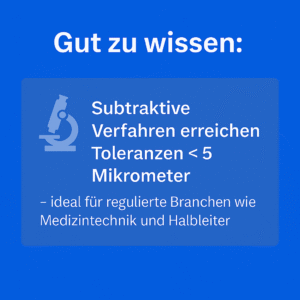
Typical subtractive manufacturing processes
CNC milling – versatile and proven
CNC milling creates three-dimensional contours by precisely controlling rotating tools along several axes. The basis is a digital CAD model, which is translated into exact tool paths using CAM software. The computer-aided process also allows complex components to be manufactured with a high degree of repeat accuracy.
The process is particularly impressive in micromachining thanks to its fine detail resolution and tight tolerances. Material transitions, hole patterns or fits can be precisely defined and reproduced. For many branches of industry, CNC milling remains the first choice when functional and geometric requirements come together.
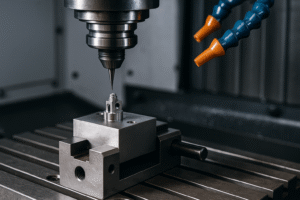
Wire EDM – precision in the micrometer range
Wire EDM uses electrical discharges to remove conductive material without mechanical contact. A fine wire – usually made of brass or tungsten – moves along predefined cutting lines through the workpiece. Even extremely hard materials such as carbide or titanium can be machined using this process.
Typical is the high accuracy with minimal thermal stress. The resulting edges are smooth and the material removal is controlled. This makes the process particularly attractive for delicate components in areas such as sensor technology or medical technology, where conventional machining methods reach their limits.

Die sinking – realizing complex 3D geometries
In die-sinking EDM, a customized electrode is lowered into the workpiece and material is removed in a targeted manner using electrical sparks. This technique enables the production of three-dimensional cavities with a high level of detail – even in hard-to-reach areas.
Undercuts, fine corner radii or structured surfaces, as required in tool and mold making or for implants, are typical. Particularly for materials with high hardness or poor machinability, die-sinking EDM is an indispensable process with stable process control.
Precision laser cutting – clean, fast and versatile
Laser cutting is ideal for thin to medium-thickness materials, especially for complex contours or tight radii. Thanks to focused light energy, the material is heated with pinpoint accuracy and vaporized or melted. Cutting widths in the range of a few tenths of a millimeter are possible without any problems.
The technology allows material thicknesses between 0.02 and 3.0 millimetres to be processed. Precise edges without burrs are created, especially for delicate components made of stainless steel, ceramic or thin sheet metal. In many cases, there is no need for subsequent processing, which saves time and money.
Spark erosion grinding – for the finest radii and profiles
This special process combines the principle of spark erosion with rotating grinding wheels. Round or rotationally symmetrical parts are machined without contact. The material is removed by controlled electrical discharges along the circumference.
Particularly noteworthy is the achievable concentricity with minimal tool wear. Even the finest profiles and microstructures can be realized. EDM grinding is therefore the preferred method for rotationally symmetrical workpieces with tight tolerances – for example in optics or piezo technology.
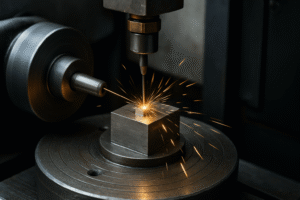
Subtractive manufacturing vs. additive manufacturing
Comparison of the advantages of subtractive methods
Subtractive processes offer decisive strengths when it comes to surface quality, dimensional accuracy and material variety. While 3D printing often requires post-processing, many subtractively manufactured parts leave the machine in their final state. This not only saves time, but also increases process reliability.
The precision is particularly striking. Structures in the micrometer range, sharp edges or fine drill holes can be realized much more reliably with subtractive techniques. There are also advantages in the choice of materials. From technical ceramics and hard metals to high-strength steels, there are virtually no limits to the processing options.
In addition, the flexibility of subtractive processes allows rapid adaptation to new requirements. Workpieces can be manufactured directly from an existing raw material. No special preparations or time-consuming programming of complex layer structures are required.
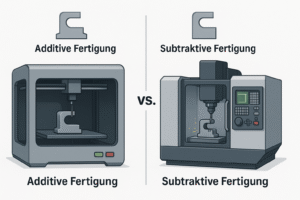
Limits of both approaches and when combinations make sense
Neither subtractive nor additive processes are superior in every situation. They show their strength where they are used in a targeted manner. Additive technologies enable rapid implementation for prototypes or components with internal channels. However, they often come up against physical limits when it comes to tolerance or surface quality requirements.
Subtractive manufacturing is particularly suitable for parts with functional surfaces, high loads or defined connection points. Many modern production processes therefore combine the two. First, the parts are built using additive processes, followed by fine machining using subtractive methods. This results in components that are both geometrically complex and highly precise.
Myths and prejudices – what is really true
It is often said that subtractive manufacturing is outdated or not economical for small batch sizes. This assumption is long outdated. Thanks to modern machine control systems, automated processes and short set-up times, it is now possible to manufacture even single items efficiently. Precision and repeatability remain at a consistently high level.
Another misconception concerns material utilization. Although waste is produced during removal, smart nesting strategies can significantly optimize material consumption. This is a relevant advantage, especially with high-quality raw materials such as titanium or carbide. In addition, many processes work with selective energy input, which can even lead to better energy efficiency compared to thermal build-up processes.
Conclusion: Subtractive processes are not outdated technology. They are ultra-modern, flexible and irreplaceable wherever precision, reliability and material diversity are required.
Areas of application in the industry
Medical technology: implants, endoscopy, instruments
Medical technology is subject to particularly strict requirements in terms of biocompatibility, traceability and microscopic precision. Subtractive processes enable the production of complex shapes made of titanium, stainless steel or high-performance ceramics with precisely defined surfaces. These properties are essential for implants as well as for instruments in minimally invasive surgery or for components in endoscopy. Certified processes in accordance with ISO 13485 also guarantee the safe implementation of medical standards.

Micromechanics: Gear wheels, sensor carriers, precision parts
Where installation space is limited and several functions have to work together in a very small space, subtractive processes show their full strength. Fine geometries, defined drilling patterns or filigree sensor holders can be produced with high repeat accuracy. Particularly with rotationally symmetrical or multi-part components, precise machining ensures an exact fit and reliable function.
Optical industry: lens holders, precision frames
Optical systems require components with high dimensional accuracy, a stable shape and stress-free alignment. Subtractive technologies ensure that lens holders or mechanical adjustment devices can be fixed precisely and permanently. Smooth cut surfaces and precise axis positions support optimum light guidance and at the same time improve efficiency during final assembly.
Semiconductor technology and piezo technology: where every µm counts
In semiconductor production and piezo-based applications, a single micrometer often determines the function. Carrier plates, contact structures or insulating separating elements must not only be geometrically precise, but also stable in terms of material. Subtractive processes such as spark erosion or laser cutting make it possible to work with high-strength or temperature-stable materials with maximum detail accuracy.
Aerospace, automotive: mastering extreme requirements
In aircraft construction and automotive engineering, the aim is to achieve maximum load-bearing capacity with minimum weight. Materials such as titanium or special aluminum alloys are in demand here, which can only be processed economically using high-precision methods. Subtractive manufacturing enables the production of complex structures with high strength and optimized surface quality. The result is components that can be used in safety-critical applications and at the same time contribute to increased efficiency.
Practical example: High-precision production of a micro part
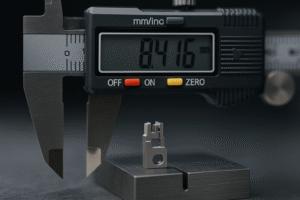
Initial situation and requirements
A leading manufacturer of sensor technology commissioned the production of a component with exceptionally tight tolerances. A complex microstructure with holes less than one millimeter in diameter, defined transitions and minimal roughness was required. The material used: a special titanium alloy substrate with high strength and limited machinability.
The challenge lay not only in miniaturization, but also in the combination of thermal stability and mechanical resilience. In addition, the surfaces had to remain free of microcraters and burrs so as not to impair the subsequent function of the sensor.
Selection of the procedure
After intensive analysis, the project team opted for a combination of wire erosion and spark erosion grinding. This choice made it possible to combine the required dimensional accuracy with maximum process reliability. In particular, the high level of detail accuracy with tight radii and the controlled machining of thermally sensitive areas were crucial.
Wire erosion was used to create the inner contours, while electrical discharge grinding enabled targeted reworking of the outer geometry. Manual reworking was not necessary, which eliminated additional process steps and minimized the risk of deviations.
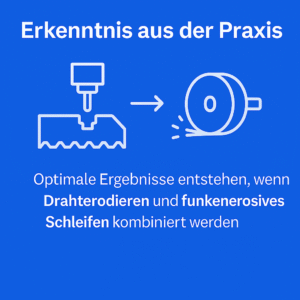
Implementation with tolerances in the µm range
Production was carried out on state-of-the-art CNC-controlled systems, equipped with real-time monitoring of the process parameters. Every cut, every hole and every shape was digitally documented and monitored by measurement technology. A repeat accuracy of less than five micrometers was consistently maintained.
To exclude thermal influences, the workpiece was actively cooled during processing. This enabled a constant dimensional accuracy and reduced the stresses in the material to a minimum. The final surface roughness was less than 0.2 micrometers, which was ideal for direct integration into the sensor setup.
Results and lessons learned for practice
The component met all technical specifications and could be transferred to series production without any further adjustments. By selecting suitable processes and continuous process monitoring, the required quality was not only achieved, but exceeded.
Important insight: Careful planning in conjunction with a suitable choice of technology is crucial for the implementation of high-precision requirements. The combination of subtractive special processes offers enormous potential in micro-manufacturing, especially when conventional machining reaches its limits.
Why subtractive manufacturing will remain indispensable in the future
Technological developments
Today, subtractive manufacturing benefits more than ever from digital advances. Modern CAM systems enable the precise implementation of even the most complex geometries. The workpiece and machine are seamlessly connected by intelligent control systems. In production practice, this leads to shorter set-up times, greater process stability and consistent results.
The advent of Industry 4.0 has fundamentally changed production in many companies. Networked production cells, automated loading systems and real-time data make the entire process more transparent and efficient. This not only makes the processing of micro parts safer, but also more economical. Artificial intelligence is also beginning to play a role in process monitoring and error detection.
Quality assurance and regulatory requirements
In many industries, compliance with norms and standards is not an add-on, but a prerequisite. Particularly in medical technology or aviation, the traceability of each production step is decisive for the approval of a product. Subtractive processes offer the necessary process control to reliably fulfill certifications such as ISO 13485 or ISO 9001.
Modern manufacturing companies document every processing step digitally. Measurement logs, machine parameters and material batches can be called up at any time. This traceability creates trust and enables transparent answers to be provided immediately in the event of queries or audits. This makes subtractive manufacturing the cornerstone of quality-assured processes.
Sustainability and new ways of thinking
Efficient use of resources is a must today. In subtractive manufacturing, material utilization and energy consumption are increasingly being optimized. Precise control and the targeted use of tools can minimize waste. This is a measurable advantage, especially with expensive materials such as titanium or high-performance ceramics.
Hybrid approaches are also gaining in importance. Additive and subtractive processes are increasingly being combined. This results in products that are both geometrically innovative and functionally reliable. Subtractive manufacturing takes care of the finishing touches, ensures precise connection points and guarantees the required tolerance.
In the long term, the role of subtractive technology will continue to develop. It will not be replaced, but complemented. Where other processes reach their limits, it will remain the stable solution – even for future requirements in a networked, sustainable industry.
When maximum precision is required: Retero as a reliable partner
When it comes to highly complex components in the micro range, many manufacturers come up against clear limits. Particularly when it comes to difficult-to-machine materials such as ceramics, carbide or titanium, in-depth expertise and state-of-the-art technology are essential. This is precisely where Retero GmbH from Switzerland comes in.
With a strong focus on micromachining and the finest tolerances, Retero offers solutions that make a real difference in regulated markets such as medical technology, optics or semiconductor technology. The company works with state-of-the-art erosion and laser technology as well as CNC-controlled manufacturing systems that are specially optimized for the micro range.
No process is left to chance. From CAD-supported planning and CAM programming to seamless quality assurance, all processes are precisely documented. ISO 9001 and ISO 13485 certifications underline the high standards of process reliability and traceability.
If you need individual geometries, complex internal contours or particularly tight fits, Retero has a solution that not only works, but also pays off economically. The combination of Swiss precision, cross-material expertise and industry knowledge makes Retero the ideal partner for companies that do not want to compromise on production quality.
Whether a single piece, small series or functional prototype part – if it really has to be precise, Retero delivers the right result. Direct. Reliably. Precisely.
Do you need precise parts that fit?
We produce what others cannot - reliably, efficiently and documented.
Conclusion: Subtractive manufacturing – classic, precise, future-proof
Subtractive manufacturing processes prove their strength whenever absolute dimensional accuracy, surface quality and material diversity are required. They are far more than a relic of classic industrial processes – they are the mainstay of modern precision manufacturing. No other process offers comparable control over contour, fit and sharpness of detail.
Companies that focus on quality and work with demanding materials such as ceramics, carbide or titanium will find a reliable solution in subtractive technology. It not only enables the implementation of complex geometries, but also compliance with regulatory requirements and integration into certified production environments.
This technology will continue to evolve in the future. Supported by digital systems, automated workflows and new hybrid approaches, it will remain a central component of intelligent manufacturing strategies. Those who are prepared to critically scrutinize existing processes and focus on precision will benefit from the potential of subtractive manufacturing in the long term.
It is not only precise. It is essential.
